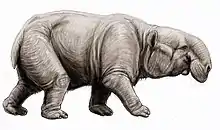| Eritreum Temporal range: Late Oligocene | |
|---|---|
| Scientific classification | |
| Domain: | Eukaryota |
| Kingdom: | Animalia |
| Phylum: | Chordata |
| Class: | Mammalia |
| Order: | Proboscidea |
| Genus: | †Eritreum Shoshani et al., 2006[1] |
| Species: | †E. melakeghebrekristosi |
| Binomial name | |
| †Eritreum melakeghebrekristosi Shoshani et al., 2006[1] | |
Eritreum melakeghebrekristosi is an extinct species of proboscidean mammal, which lived in Northeast Africa during the late Oligocene some 27 million years ago, and is considered to be the missing link between modern elephants and their ancestors. The fossils of this species are the oldest known fossils featuring the horizontal tooth displacement seen in modern elephants. The species is estimated to have weighed 484 kg (1,067 lb) and stood about 1.3 m (4.3 ft) at the shoulder, much smaller than modern species.
The generic name Eritreum comes from Eritrea, the country in the Horn of Africa where the specimen was discovered. The specific name melakeghebrekristosi honors Melake Ghebrekristos, the farmer who found the specimen.
References
- 1 2 J. Shoshani, R. C. Walter, M. Abraha, S. Berhe, P. Tassy, W. J. Sanders, G. H. Marchant, Y. Libsekal, T. Ghirmai and D. Zinner. 2006.A proboscidean from the late Oligocene of Eritrea, a "missing link" between early Elephantiformes and Elephantimorpha, and biogeographic implications. Proceedings of the National Academy of Sciences 103(46): 17296-17301
External links
- Bryner, Jeanna (2006-09-01). "'Missing Link' of Elephant Family Unearthed". LiveScience. Archived from the original on 2006-11-02. Retrieved 2006-09-14.
This article is issued from Wikipedia. The text is licensed under Creative Commons - Attribution - Sharealike. Additional terms may apply for the media files.


